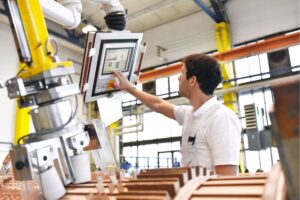Writer: Ryan Gandolfo
 2 min read May 2022 — Pittsburgh is in a prime position to lead the changing landscape of manufacturing as the United States puts a greater emphasis on additive manufacturing (AM).
2 min read May 2022 — Pittsburgh is in a prime position to lead the changing landscape of manufacturing as the United States puts a greater emphasis on additive manufacturing (AM).
On May 6, Additive Manufacturing Forward (AM Forward), a voluntary public-private compact, was launched to give U.S.-based small and medium businesses the tools and resources to further their adoption of 3D printing technology. The push highlights the need to increase resilience in supply chains, which have been battered by the pandemic and subsequent economic impact.
The federal initiative can look to Pittsburgh’s Neighborhood 91 project, an AM production hub at the Pittsburgh International Airport that started in 2020, for a roadmap to develop additive manufacturing capacity.
The region has long been known for its manufacturing prowess, and Neighborhood 91 shows a blueprint to the future of AM. The campus connects manufacturers to all elements of the AM manufacturing process to improve their businesses and was set up in part to solve supply chain issues by producing metal additives to reduce reliance on imports.
“At Pittsburgh International Airport, Neighborhood 91 is a complete manufacturing and transportation ecosystem for additive manufacturing, and it’s ready to serve as a reshoring model because it’s strategically located right near the airport for use of distribution when air cargo is required for shipping. It’s building out and enabling more domestic manufacturing and bringing products closer to US businesses and customers. We think that this very unique model, where the supply chain is essentially located in one space, is a good example of how the country can develop homegrown additive manufacturing. Pittsburgh and that particular project at Pittsburgh International Airport can be a real model for shortening those supply chain difficulties,” Matt Smith, president of the Greater Pittsburgh Chamber of Commerce, told Invest:.
To date, passenger rail transport equipment provider Wabtec and additive manufacturing leader Cumberland have moved into the campus to develop and grow their core competencies in AM. Major firms such as GE have also established additive manufacturing facilities in Allegheny County.
The Neighborhood 91 White Paper, published in 2020, stated that the campus will “act as a catalyst for AM industrialization and innovation with the creation of a cost-efficient ecosystem and the collection of smart people.” This includes a projected 80% reduction in manufacturing lead time and an 80 to 100% reduction in transportation costs for powder to part production.
Some of the challenges associated with AM are the high investment and training costs, which have deterred many small manufacturers from exploring the technologies previously. According to the SBA, there are nearly 600,000 small manufacturers that make up 99% of the U.S. manufacturing industry, and generate 5 million jobs and $1 trillion in gross revenue.
The AM Forward initiative plans to bridge the financial and educational gaps by encouraging large corporations, such as GE Aviation, Honeywell and Siemens Energy, to increase demand for additively produced parts as well as provide opportunities to train their suppliers’ staff. Another goal of the initiative is to develop standards in the industry.
Given Neighborhood 91’s head start in the additive manufacturing space, not only for research and development but also to produce real output, Pittsburgh is expected to be a long-term hub for manufacturing innovation and improve supply chains.
“In Pittsburgh, companies are working to future-proof the supply chain to increase resiliency and make sure that any external disruptions have as little impact as possible on their operations. So, from driverless vehicles to robotics, innovations in this region are at the forefront of how we can create a very narrow supply chain for our region to succeed,” said Smith.

